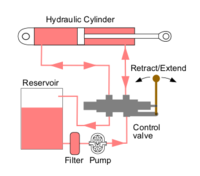
Photo from wikipedia
Coarse bed load transport is a crucial process in river morphodynamics but is difficult to monitor in mountain streams. Here we present a new sediment transport dataset obtained from two… Click to show full abstract
Coarse bed load transport is a crucial process in river morphodynamics but is difficult to monitor in mountain streams. Here we present a new sediment transport dataset obtained from two years of field‐based monitoring (2014‐2015) at the Estero Morales, a high‐gradient stream in the central Chilean Andes. This stream features step‐pool bed geometry and a glacier‐fed hydrologic regime characterized by abrupt daily fluctuations in discharge. Bed load was monitored directly using Bunte samplers and by surveying the mobility of PIT (passive integrated transponder) tags. We used the competence method to quantify the effective slope, which is the fraction of the topographical slope responsible for bed load transport. This accounts for only 10% of the topographical slope, confirming that most of the energy is dissipated on macroroughness elements. We used the displacement lengths of PIT tags to analyze displacement lengths and virtual velocity of a wide range of tracer sizes (38‐415 mm). Bed load transport in the Estero Morales show to be size‐selective and the distance between steps influences the displacement lengths of PIT tags. Displacement lengths were also used to derive the statistics of flight distances and resting times. Our results show that the average length of flight scales inversely to grain size. This contradicts Einstein's conjecture about the linear relationship between grain size and intervals between resting periods in a steep step‐pool stream in ordinary flood conditions.
Journal Title: Journal of Geophysical Research
Year Published: 2020
Link to full text (if available)
Share on Social Media: Sign Up to like & get
recommendations!